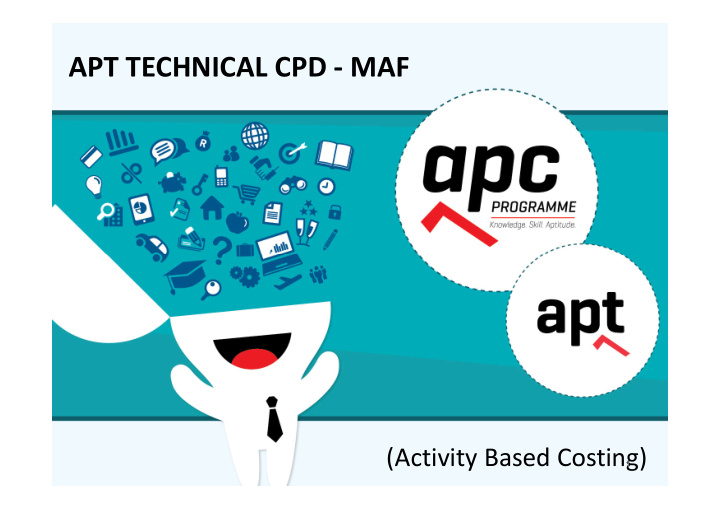



APT TECHNICAL CPD - MAF (Activity Based Costing) 1
Activity Based Costing Nicholas Riemer Nicholas.Riemer@firstrand.co.za
Agenda • Workflow to understanding ABC Costing • What is activity based costing? Generic Problem • What is the specific industry? • What is the specific problem? • How to incorporate into your file
ABC Workflow Approach
What is activity based costing? Generic problem • A different way of allocating fixed overheads • Importance of cost drivers • More accurate form of costing which improves profitability/performance measurement in cost and management accounting systems • Fixed overheads have become the most significant component of total cost. • Cost allocation important for (and therefor accurate allocation crucial) Profit and performance measurement as well as pricing and decision-making.
Why did it arise??? • Traditional costing system – How do we calculate the overhead allocation rate? – Fixed overhead / number of something – Something??? Direct labour / machine hours / volume • Consider the following example – Take 2 factories • 1000 red pens vs a factory that makes 800 red, 100 green, 50 blue, 50 black • Are the fixed costs of the two factories the same?
Why did it arise??? (continued…) – So what’s happening? • High volume product is pulling most of the cost • But we know this is not correct, why??? – Therefore misleading info for decision-making leading to death spiral – Therefore activity based costing • The realisation that there are costs that are incurred independent of volume
Traditional costing system Overhead cost accounts Cost Cost Cost centre 1 centre 2 centre 3 Volume driven (labour hrs/ machine hours) Products
Activity based costing Overhead cost accounts VALUE Activity 1 Activity 2 Activity 3 CHAIN Cost driver Products
Why did it arise? (continued…) • Due to weaknesses in the traditional costing systems – In the past • Direct costs Dominant • Overheads minimal • Fewer products • Low competition • Information was expensive • Limited number of service organisations
Comparing Absorption vs ABC • Both treat direct costs exactly the same • Both involve the allocation of fixed overheads, so under/over-recovery still arises • But the way fixed overheads are allocated differs: – TCS • Setup costs / number of products – ABC • Setups (Activity) • Driver = number of setups • Allocate the cost to the product that requires more setups
Four stages involved in designing an ABC system • Stage 1 – Identify the various activities within the organisation • Groups of similar tasks – purchasing, setup, receiving • Based on the value chain • Don’t group too much – Can you find a cost driver? – Cost benefit • Stage 2 – Assigning costs to activity centres • Keep the costs as direct as possible
Four stages involved in designing an ABC system • Stage 3 – Selecting appropriate cost drivers • Measurable • Easy to obtain • Identifiable with products • Stage 4 – Assigning activity costs to products • Based on the product’s demand for the activity
Specific Industry? • What is the industry? • How does this industry apply ABC costing? • Research, but what kind of research? What type of information are you looking for? • Are you applying the technical detail of the topic to the industry in your research time?
Industry Aviation: • In the pre release the aviation industry is triggered. • How would I handle this industry? • 1) Identify the technical concepts and basics of ABC costing • 2) Start with general research, google. What are you seeing • 3) From simple research you will identify the key issues at hand, that aviation is solely fixed cost driven. Vast majority (if not all costs) are indirect and therefore crucial to determine the true cost of services for pricing; profit and performance measurement – also decision-making is improved if costs are better understood. How do you value a business class ticket to a specific destination. • This is what you are identifying NB and you are linking to the technical. • Really understanding how the aviation industry uses ABC costing to allocate fixed costs. Airline example:
Airline example – What are the key points from practical research? – Total costs identified per plane and flight – Cost drivers identified for allocation to planes and flights. – Costs allocated – Planes and flights are then allocated to routes. – From this the total route costs are divided among passengers to work out the cost per passenger. – Lastly Variable costs per ticket then added to work out total cost per ticket. – Key Industry understanding NB
Specific Case study • What is the specific problem for the specific case • Determine which services/products does the specific company have (routes; business economy etc.) Might also be important for divisions within the company . • Now link Technical, Industry research the case study at hand. • Not predicting the question for the day. Arriving with a full tool box. • Coverage Coverage Coverage NB
Building a file for coverage • My File. • Everything summarized in sequence NB • You got this.
Recommend
More recommend